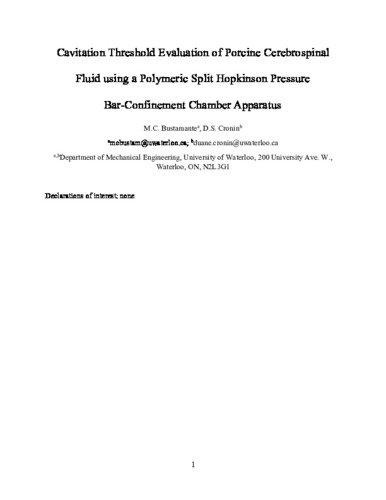| dc.contributor.author | Bustamante, Mike | |
| dc.contributor.author | Cronin, Duane | |
| dc.date.accessioned | 2024-01-25 19:14:02 (GMT) | |
| dc.date.available | 2024-01-25 19:14:02 (GMT) | |
| dc.date.issued | 2019-12 | |
| dc.identifier.uri | https://doi.org/10.1016/j.jmbbm.2019.103400 | |
| dc.identifier.uri | http://hdl.handle.net/10012/20292 | |
| dc.description | The final publication is available at Elsevier via https://doi.org/10.1016/j.jmbbm.2019.103400. © 2019. This manuscript version is made available under the CC-BY-NC-ND 4.0 license http://creativecommons.org/licenses/by-nc-nd/4.0/ | en |
| dc.description.abstract | Studies investigating mild Traumatic Brain Injury (mTBI) in the military population using experimental head surrogates and Finite Element (FE) head models have demonstrated the existence of transient negative pressures occurring within the head at the contrecoup location to the blast wave impingement. It has been hypothesized that this negative pressure may cause cavitation of cerebrospinal fluid (CSF) and possibly lead to brain tissue damage from cavitation bubble collapse. The cavitation pressure threshold of human CSF is presently unknown, although existing FE studies in the literature have assumed a value of -100 kPa. In the present study, the cavitation threshold of degassed porcine CSF at body temperature (37 °C) was measured using a unique modified Polymeric Split Hopkinson Pressure Bar apparatus, and compared to thresholds of distilled water at various conditions. The loading pulse generated in the apparatus was comparable to experimentally measured pressures resulting from blast exposure, and those predicted by an FE model. The occurrence of cavitation was identified using high-speed imaging and the corresponding pressures were determined using a computational model of the apparatus that was previously developed and validated. The probability of cavitation was calculated (ISO/TS, 18506) from forty-one experimental tests on porcine CSF, representing an upper bound for in vivo CSF. The 50% probability of cavitation for CSF (-0.467 MPa ± 7%) was lower than that of distilled water (-1.37 MPa ± 16%) under the same conditions. The lesser threshold of CSF could be related to the constituents such as blood cells and proteins. The results of this study can be used to inform FE head models subjected to blast exposure and improve prediction of the potential for CSF cavitation and response of brain tissue. | en |
| dc.language.iso | en | en |
| dc.publisher | Elsevier | en |
| dc.relation.ispartofseries | Journal of the Mechanical Behavior of Biomedical Materials;100; 103400 | |
| dc.rights | Attribution-NonCommercial-NoDerivatives 4.0 International | * |
| dc.rights.uri | http://creativecommons.org/licenses/by-nc-nd/4.0/ | * |
| dc.subject | cavitation | en |
| dc.subject | mild traumatic brain injury | en |
| dc.subject | negative intracranial pressure | en |
| dc.subject | polymeric split Hopkinson pressure bar | en |
| dc.subject | Porcine cerebrospinal fluid | en |
| dc.title | Cavitation threshold evaluation of porcine cerebrospinal fluid using a Polymeric Split Hopkinson Pressure Bar-Confinement chamber apparatus | en |
| dc.type | Article | en |
| dcterms.bibliographicCitation | Bustamante, M. C., & Cronin, D. S. (2019). Cavitation threshold evaluation of porcine cerebrospinal fluid using a polymeric split Hopkinson pressure bar-confinement chamber apparatus. Journal of the Mechanical Behavior of Biomedical Materials, 100, 103400. https://doi.org/10.1016/j.jmbbm.2019.103400 | en |
| uws.contributor.affiliation1 | Faculty of Engineering | en |
| uws.contributor.affiliation2 | Mechanical and Mechatronics Engineering | en |
| uws.typeOfResource | Text | en |
| uws.peerReviewStatus | Reviewed | en |
| uws.scholarLevel | Faculty | en |


